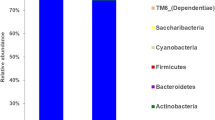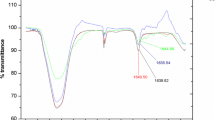Abstract
The aim of this study is to evaluate the effects of the inoculation of the saltmarsh plant (Halimione portulacoides) with Pseudomonas sp. SPN31 nah+ combined with exposure to 2-methylnaphthalene (2-MtN) on the plant rhizosphere and endosphere bacterial communities as well as on plant health. To achieve this goal, microcosm experiments were set up. Denaturing gradient gel electrophoresis (DGGE) profiles and statistical analysis showed that rhizosphere and endosphere bacterial communities had distinct responses to plant inoculation and/or exposure to 2-MtN. PCR-sequencing analysis of nah genes encoding for 2-MtN degrading enzymes suggested the presence of Pseudomonas sp. SPN31 nah+ in the endosphere of H. portulacoides with 2-MtN contamination. Moreover, a significant effect in the photosynthetic performance of inoculated plants was detected. To conclude, despite the potential beneficial effect of plant inoculation with Pseudomonas sp. SPN31 nah+ endophytic bacteria may have on plant health, no significant effect on the removal of MtN was detected for the level of contamination used in the study.


Similar content being viewed by others
References
Afzal M, Yousaf S, Reichenauer TG, Kuffner M, Sessitsch A (2011) Soil type affects plant colonization, activity and catabolic gene expression of inoculated bacterial strains during phytoremediation of diesel. J Hazard Mater 186:1568–1575
Andreolli M, Lampis S, Poli M, Gullner G, Biró B, Vallini G (2013) Endophytic Burkholderia fungorum DBT1 can improve phytoremediation efficiency of polycyclic aromatic hydrocarbons. Chemosphere 92:688–694
Andreote FD, Da Rocha UN, Araújo WL, Azevedo JL, van Overbeek LS (2010) Effect of bacterial inoculation, plant genotype and developmental stage on root-associated and endophytic bacterial communities in potato (Solanum tuberosum). Antonie Van Leeuwenhoek 97:389–399
Anjum NA, Ahmad I, Válega M et al (2013) Salt marsh halophyte services to metal-metalloid remediation: assessment of the processes and underlying mechanisms. Crit Rev Environ Sci Technol 44:2038–2106.
Barac T, Taghavi S, Borremans B et al (2004) Engineered endophytic bacteria improve phytoremediation of water-soluble, volatile, organic pollutants. Nat Biotechnol 22:583–588
Brannock JM (2004) Charaterization of root endophytic bacteria. Doctoral Thesis, University of Cincinnati, pp. 87
Cébron A, Norini MP, Beguiristain T, Leyval C (2008) Real-Time PCR quantification of PAH-ring hydroxylating dioxygenase (PAH-RHDalpha) genes from Gram positive and Gram negative bacteria in soil and sediment samples. J Microbiol Methods 73:148–159
Coelho FJ, Sousa S, Santos L, Santos AL, Almeida A, Gomes N, Cunha  (2011) Exploring hydrocarbonoclastic bacterial communities in the estuarine surface microlayer. Aquat Microb Ecol 64:185–195
Couto M, Basto M, Vasconcelos M (2011) Suitability of different salt marsh plants for petroleum hydrocarbons remediation. Chemosphere 84:1052–1057
Dubinsky EA, Conrad ME, Chakraborty R et al (2013) Succession of hydrocarbon-degrading bacteria in the aftermath of the Deepwater Horizon oil spill in the Gulf of Mexico. Environ Sci Technol 47:10860–10867
Escalante-Espinosa E, Gallegos-Martínez M, Favela-Torres E, Gutiérrez-Rojas M (2005) Improvement of the hydrocarbon phytoremediation rate by Cyperus laxus Lam. inoculated with a microbial consortium in a model system. Chemosphere 59:405–413
Fodelianakis S, Antoniou E, Mapelli F et al (2015) Allochthonous bioaugmentation in ex situ treatment of crude oil-polluted sediments in the presence of an effective degrading indigenous microbiome. J Hazard Mater 287:78–86
Gaiero JR, McCall CA, Thompson KA, Day NJ, Best AS, Dunfield KE (2013) Inside the root microbiome: bacterial root endophytes and plant growth promotion. Am J Bot 100:1738–1750
Gao Y, Zhu L (2004) Plant uptake, accumulation and translocation of phenanthrene and pyrene in soils. Chemosphere 55:1169–1178
Germaine KJ, Keogh E, Ryan D, Dowling DN (2009) Bacterial endophyte-mediated naphthalene phytoprotection and phytoremediation. FEMS Microbiol Lett 296:226–234
Glick BR (2010) Using soil bacteria to facilitate phytoremediation. Biotechnol Adv 28:367–374
Gomes NCM, Kosheleva IA, Abraham WR, Smalla K (2005) Effects of the inoculant strain Pseudomonas putida KT2442 (pNF142) and of naphthalene contamination on the soil bacterial community. FEMS Microbiol Ecol 54:21–33
Gomes NCM, Borges LR, Paranhos R, Pinto FN, Mendonca-Hagler LC, Smalla K (2008) Exploring the diversity of bacterial communities in sediments of urban mangrove forests. FEMS Microbiol Ecol 66:96–109
Gurska J, Wang W, Gerhardt KE et al (2009) Three year field test of a plant growth promoting rhizobacteria enhanced phytoremediation system at a land farm for treatment of hydrocarbon waste. Environ Sci Technol 43:4472–4479
Heuer H, Krsek M, Baker P, Smalla K, Wellington E (1997) Analysis of actinomycete communities by specific amplification of genes encoding 16S rRNA and gel-electrophoretic separation in denaturing gradients. Appl Environ Microbiol 63:3233–3241
Heuer H, Wieland G, Schönfeld J, Schönwälder A, Gomes NCM, Smalla K (2001) Bacterial community profiling using DGGE or TGGE analysis. Environ Mol Microbiol: Protoc Appl 9:177–190
Hoagland DR, Arnon DI (1950) The water-culture method for growing plants without soil. California Agric Exp Stn Circ 347
Jones RK, Sun WH, Tang C-S, Robert FM (2004) Phytoremediation of petroleum hydrocarbons in tropical coastal soils II. microbial response to plant roots and contaminant. Environ Sci Pollut R 11:340–346
Leahy JG, Colwell RR (1990) Microbial degradation of hydrocarbons in the environment. Microbiol Res 54:305–315
Lin Q, Shen KL, Zhao HM, Li WH (2008) Growth response of Zea mays L. in pyrene–copper co-contaminated soil and the fate of pollutants. J Hazard Mater 150:515–521
Ma Y, Wang L, Shao Z (2006) Pseudomonas, the dominant polycyclic aromatic hydrocarbon-degrading bacteria isolated from Antarctic soils and the role of large plasmids in horizontal gene transfer. Environ Microbiol 8:455–465
Maldonado-González MM, Prieto P, Mercado-Blanco J (2015) Endophytic colonization and biocontrol performance of Pseudomonas fluorescens PICF7 in olive (Olea europaea L.) are determined neither by pyoverdine production nor swimming motility. Environ Microbiol 17:3139–3153
Mansur AA, Adetutu EM, Makadia T, Morrison PD, Ball AS (2015) Assessment of the hydrocarbon degrading abilities of three Bioaugmentation agents for the bioremediation of crude oil tank bottom sludge Contaminated Libyan soil. Int J Environ Bioremed Biodegradation 3:1–9
Nedbal L, Trtìlek M, Herppich W (2000) Methods and equipment for fluorescence imaging on plant material. Bornimer Agrartechn Ber 25:127–135
Nie M, Wang Y, Yu J et al (2011) Understanding plant-microbe interactions for phytoremediation of petroleum-polluted soil. PloS One 6:e17961
Oksanen J, Blanchet FG, Kindt R et al (2011) vegan: Community Ecology Package. R package version 2.0–0
Oliveira V, Gomes NCM, Cleary DF et al (2014) Halophyte plant colonization as a driver of the composition of bacterial communities in salt marshes chronically exposed to oil hydrocarbons. FEMS Microbiol Ecol 90:647–662
Oliveira V, Gomes NCM, Almeida A, Silva A, Simões MM, Smalla K, Cunha  (2014) Hydrocarbon contamination and plant species determine the phylogenetic and functional diversity of endophytic degrading bacteria. Mol Ecol 23:1392–1404
Pacwa-Płociniczak M, Płaza GA, Poliwoda A, Piotrowska-Seget Z (2014) Characterization of hydrocarbon-degrading and biosurfactant-producing Pseudomonas sp. P-1 strain as a potential tool for bioremediation of petroleum-contaminated soil. Environ Sci Pollt R 21:9385–9395
Paliwal V, Raju SC, Modak A, Phale PS, Purohit HJ (2014) Pseudomonas putida CSV86: A candidate genome for genetic bioaugmentation. PloS One 9:e84000
Park JW, Crowley DE (2006) Dynamic changes in nahAc gene copy numbers during degradation of naphthalene in PAH-contaminated soils. Appl Microbiol Biotechnol 72:1322–1329
Phillips LA, Greer CW, Germida JJ (2006) Culture-based and culture-independent assessment of the impact of mixed and single plant treatments on rhizosphere microbial communities in hydrocarbon contaminated flare-pit soil. Soil Biol Biochem 38:2823–2833
Phillips LA, Germida JJ, Farrell RE, Greer CW (2008) Hydrocarbon degradation potential and activity of endophytic bacteria associated with prairie plants. Soil Biol Biochem 40:3054–3064
Ponsin V, Coulomb B, Guelorget Y, Maier J, Höhener P (2014) In situ biostimulation of petroleum hydrocarbon degradation by nitrate and phosphate injection using a dipole well configuration. J Contam Hydrol 171:22–31
Rikalovic MG, Abdel-Mawgoud AM, Déziel E, Gojgic-Cvijovic GD, Nestorovic Z, Vrvic MM, Karadzic IM (2013) Comparative analysis of Rhamnolipids from novel environmental isolates of Pseudomonas aeruginosa. J Surfactants Deterg 16:673–682
Silva I, Rocha SM, Coimbra MA, Marriott PJ (2010) Headspace solid-phase microextraction combined with comprehensive two-dimensional gas chromatography time-of-flight mass spectrometry for the determination of volatile compounds from marine salt. J Chromatogr A 1217:5511–5521
Singer AC, Crowley DE, Thompson IP (2003) Secondary plant metabolites in phytoremediation and biotransformation. Trends Biotechnol 21:123–130
Sun T-R, Cang L, Wang Q-Y, Zhou D-M, Cheng J-M, Xu H (2010) Roles of abiotic losses, microbes, plant roots, and root exudates on phytoremediation of PAHs in a barren soil. J Hazard Mater 176:919–925
Taghavi S, Barac T, Greenberg B, Borremans B, Vangronsveld J, van der Lelie D (2005) Horizontal gene transfer to endogenous endophytic bacteria from poplar improves phytoremediation of toluene. Appl Environ Microbiol 71:8500–8505
Top EM, Springael D (2003) The role of mobile genetic elements in bacterial adaptation to xenobiotic organic compounds. Curr Opin Biotechnol 14:262–269
Top EM, Springael D, Boon N (2002) Catabolic mobile genetic elements and their potential use in bioaugmentation of polluted soils and waters. FEMS Microbiol Ecol 42:199–208
Wasi S, Tabrez S, Ahmad M (2013) Use of Pseudomonas spp. for the bioremediation of environmental pollutants: a review. Environ Monit Assess 185:8147–8155
Wilson MS, Bakermans C, Madsen EL (1999) In situ, real-time catabolic gene expression: extraction and characterization of naphthalene dioxygenase mRNA transcripts from groundwater. Appl Environ Microbiol 65:80–87
Yousaf S, Andria V, Reichenauer TG, Smalla K, Sessitsch A (2010) Phylogenetic and functional diversity of alkane degrading bacteria associated with Italian ryegrass (Lolium multiflorum) and Birdsfoot trefoil (Lotus corniculatus) in a petroleum oil-contaminated environment. J Hazard Mater 184:523–532
Yousaf S, Afzal M, Reichenauer TG, Brady CL, Sessitsch A (2011) Hydrocarbon degradation, plant colonization and gene expression of alkane degradation genes by endophytic Enterobacter ludwigii strains. Environ Pollut 159:2675–2683
Funding
The funding was provided by Fundação para a Ciência e a Tecnologia, Fundação para a Ciência e Tecnologia—FCT and Programa Operacional Factores de Competitividade.
Author information
Authors and Affiliations
Corresponding author
Ethics declarations
Conflict of interest
The authors declare that they have no conflict of interest.
Electronic supplementary material
Below is the link to the electronic supplementary material.
Rights and permissions
About this article
Cite this article
Oliveira, V., Gomes, N.C.M., Santos, M. et al. Effects of the Inoculant Strain Pseudomonas sp. SPN31 nah + and of 2-Methylnaphthalene Contamination on the Rhizosphere and Endosphere Bacterial Communities of Halimione portulacoides . Curr Microbiol 74, 575–583 (2017). https://doi.org/10.1007/s00284-017-1197-y
Received:
Accepted:
Published:
Issue Date:
DOI: https://doi.org/10.1007/s00284-017-1197-y




